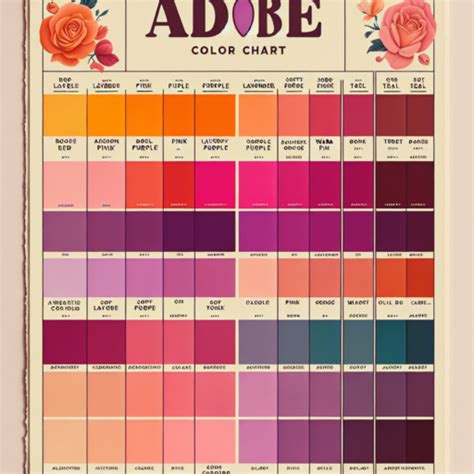Understanding the Adore Color Chart
The Adore Color Chart is a visual tool that displays the relationships between different colors, providing a comprehensive guide for color selection and combinations. It is a valuable resource for designers, artists, and anyone looking to create visually appealing color schemes.

Color Theory Basics
The Adore Color Chart is based on the principles of color theory, which describes the interaction of colors and their effects on human perception. The chart organizes colors into three main categories:
- Primary Colors: Red, yellow, and blue are the fundamental colors from which all other colors are created.
- Secondary Colors: Orange, green, and violet are created by mixing primary colors in equal proportions.
- Tertiary Colors: These colors are created by mixing a primary color with its adjacent secondary color, resulting in shades like red-orange, yellow-green, and blue-violet.
Using the Adore Color Chart
The Adore Color Chart can be used to:
- Identify Complementary Colors: Colors that appear opposite each other on the chart are considered complementary and create high-contrast combinations.
- Create Analogous Color Schemes: Colors that are adjacent to each other on the chart produce harmonious and cohesive schemes.
- Explore Triadic Color Schemes: These schemes involve using three colors that are equidistant from each other on the chart, resulting in vibrant and dynamic combinations.
Practical Applications of the Adore Color Chart
The Adore Color Chart has a wide range of applications in various fields:
- Interior Design: Choosing color palettes for paint, furniture, and decorative elements to create visually appealing and inviting spaces.
- Fashion: Selecting colors for clothing, accessories, and makeup to enhance aesthetic appeal and personal style.
- Marketing: Developing brand colors, packaging designs, and advertising materials that convey the desired message and evoke emotions.
- Web Design: Creating user interfaces and website layouts with appropriate color combinations to guide navigation and enhance usability.
Common Mistakes to Avoid
When using the Adore Color Chart, avoid these common mistakes:
- Overusing Bright Colors: While bright colors can create a vibrant effect, it is important to balance them with neutral or muted tones to prevent overwhelming the senses.
- Ignoring Value and Saturation: Consider the value (lightness or darkness) and saturation (intensity) of colors to create a sense of depth and contrast.
- Neglecting Color Psychology: Different colors evoke different emotions and associations, so it is essential to consider the psychological impact of color choices.
Step-by-Step Approach to Using the Adore Color Chart
- Identify Your Target Color: Choose the color that you want to base your scheme around.
- Find Complementary, Analogous, or Triadic Colors: Use the chart to identify colors that complement, harmonize, or create a dynamic contrast with your target color.
- Consider Value and Saturation: Adjust the brightness, darkness, and intensity of the colors to achieve the desired effect.
- Test Your Combinations: Experiment with different color combinations and view them in different lighting conditions to ensure they work well together.
- Refine and Adjust: Make any necessary adjustments to the colors and their proportions until you find the perfect combination.
Conclusion
The Adore Color Chart is an invaluable tool for anyone looking to navigate the world of color with confidence. By understanding color theory and using the chart effectively, you can create visually stunning and emotionally resonant color schemes for a variety of applications. Embrace the power of color and let the Adore Color Chart guide your journey towards color harmony.
